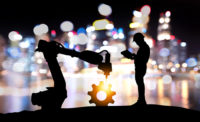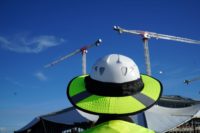Proactive safety in construction
Construction is one of the world’s most dangerous industries. Even with an increased focus on safety in recent years, 806 deaths and over 300,000 injuries occurred in 2012 in the U.S. alone.1,2,3 On-the-job injuries cost the construction industry billions each year. It takes an average $5.4 million in additional revenue to offset the costs associated with a single non-fatal injury.4 Costs of a death are even higher, with the highest costs borne by the family, friends and co-workers of those who die.
Leading construction companies and industry organizations have been working for years to continuously improve safety on the jobsite. Companies such as Kiewit, Skanska, and Turner are spending time and money to build proactive safety programs focused on more than just compliance — programs that anticipate potential issues and provide the equipment, education and support to ensure they do not become actual issues.
Though safety programs are growing increasingly proactive, most of the safety products currently on the market are focused on passive rather than active solutions.
Fortunately, the concept of “active safety” is at a tipping point in the construction industry. New safety products incorporate modern technologies to change what it means to be safe on the job. Light-emitting diodes (LEDs) and advancements in battery technologies are rewriting the rules for jobsite illumination. Wireless technologies like Bluetooth are changing the way we communicate on the job, while radio-frequency identification (RFID) technology increases the means by which we can view people and equipment on the job. New composite materials are making our gear stronger and lighter. Technologies like accelerometers and gyroscopes measure the speed, distance and orientation of wearable technology solutions.
The future of jobsite safety
From a safety perspective, future jobsites will look very different from those we see today. Today’s jobsites are closed and isolated silos of independent systems and workflow. In the future they will be connected and open.
Personal Active Safety Systems that combine hardware and software are the next major step in the evolution of personal safety. Such systems allow supervisors, safety managers and equipment operators to identify every worker on site visually or virtually at all times. They will also report back important statistics on worker health and safety, such as heart rate, temperature, and even direction and velocity of movement.
The ability to track all this information on a smartphone or tablet may sound like science fiction, but is close to becoming a reality. And that reality will save lives.
Today, when there is a jobsite evacuation (e.g. due to fire, gas leak, or chemical spill), the only way to know if everyone is safely off the jobsite is to do a manual headcount. With active safety solutions, safety personnel will be able to use their smartphone or tablet to determine whether everyone is clear of the evacuation area and to provide first responders with the exact location of anyone still in danger.
Crane operators will be able to see a live feed of everyone in the path of their load and notify people to clear out.
Supervisors will receive alerts if a worker’s vitals are at dangerous levels or if a worker falls (measured through a combination of speed, direction of movement, and other factors).
All of this becomes possible on a jobsite where the wearable technologies (gear with integrated hardware) worn by an individual are connected to an intelligent software platform.
The ubiquity of technology today is driving down the cost of hardware and software, so these safety solutions will be affordable as well as effective. They will also help pay for themselves by increasing efficiency and preventing injuries. No longer will anyone spend 15 minutes searching for the site supervisor to ask a question. Instead, he or she will turn on their smartphone and be able to see the supervisor’s exact location. The need for re-work, which costs anywhere from 2 percent to 20 percent of a project’s contract fees, will be reduced by wearable LED lighting solutions that better illuminate a worker’s task area.5
Beyond the construction site
Personal Active Safety Solutions have applications well beyond the construction industry. They will benefit anyone working in high-risk environments including miners, longshoremen, oil and gas workers, railroad line crews, first responders and fire safety personnel.



